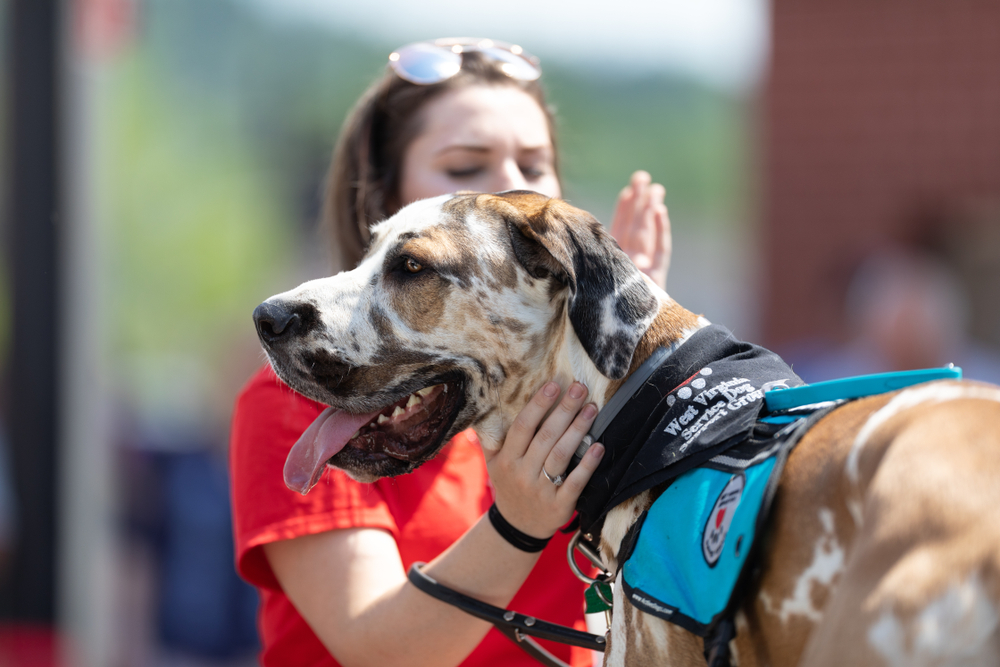At CertaPet, we are a dedicated team focused on one thing: Getting people in need the help they deserve as quickly as possible. Whether from a psychiatric service dog or an emotional support animal, our easy and painless 3 step process will direct you down the path to regaining the power to live a life free from stress and worry.
The purpose of this article is to inform and educate people about the service dog world, the differences between a therapy dog, another term for a psychiatric service dog, and a support dog or emotional support animal.
We relay how they can help all people who suffer from a mental illness, how they are specifically trained, and how we can help you acquire one for yourself.
What is Mental Illness?

Mental illnesses are health conditions involving changes in emotion, thinking or behavior (or a combination of these). Mental illnesses are associated with distress and/or problems functioning in social, work or family activities.
Mental illness does not discriminate; it can affect anyone regardless of your age, gender, geography, income, social status, race/ethnicity, religion/spirituality, sexual orientation, background or other aspect of cultural identity. While mental illness can occur at any age, three-fourths of all mental illness begins by age 24.
Mental illnesses take many forms. Some are mild and only interfere in limited ways with daily life, such as certain phobias (abnormal fears). Other mental health conditions are so severe that a person may need care in a hospital. Psychiatry.org gives great insight into this complicated, yet common, subject.
Common Treatments and Coping Mechanisms for Mental Illness
Learning you have a mental health condition can be upsetting and dealing with associated symptoms can be daunting. But there is hope. There are a variety of treatments available for mental health conditions. Don’t be afraid to ask for help.
The most popular, traditional medicine treatments are:
- Psychotherapy or Counseling
- Prescription Medicine
- Support Groups
- Exercise and Creativity Based Therapies
- Eye Movement Desensitization and Reprocessing (EMDR) therapy
- Hospitalization or a Residential Treatment Program
As more and more people seek holistic alternatives when developing their treatment plans, the use of assistance animals such as psychiatric service dogs is becoming more commonplace. The complete discussion of treatments and alternatives can be found here.
What are Psychiatric Service Dogs?
A psychiatric service dog (PSD) is a type of assistance animal/emotional support animal that’s trained to perform specific tasks for individuals living with a mental illness. These unique tasks are directly related to the handler’s disability.
The ADA, Americans With Disabilities Act, has compiled Frequently Asked Questions and comprehensive, revised requirements, specifically about assistance dog use, service animals, psychiatric service dogs, and more.
Most of us are accustomed to seeing guide dogs supporting those with physical disabilities like a hearing or sight impairment. However, a psychiatric service animal helps people with typically unseen, unnoticeable disabilities.
For example, veterans with post-traumatic stress disorder (PTSD) who experience panic attacks or similar challenges can greatly benefit from the service of a PSD. Those who live with symptoms like social phobia, depression or other depressive disorders can also find the service of a PSD to be incredibly beneficial.
CertaPet’s Blog is updated weekly and full of informative articles, testimonials, and data from mental health and professionals. For a more in-depth overview of this complicated subject, read our full article.
Click the below video to learn more about psychiatric service dogs.
How Can Service Dogs Help with Mental Illness?

Service dogs are most commonly thought of as helping the physically impaired. However, as mental health becomes a more acceptable topic, psychiatric service dogs are starting to make a public appearance. Psychiatric service dogs help people cope with a mental disorder and improve their quality of life with specifically trained behaviors. From keeping crowds at bay to fetching medication, here are a few ways a service dog can help someone with a mental disorder.
Mental Health Benefits
Just having a dog in your life, through their innate characteristics, can combat your mental health issues greatly. Certified and trained service dogs are an optimized, personalized version, able to tackle even more problems for you; to name a few:
- Reduce anxiety and Treat Panic Attacks
- Aid children with Autism and ADHD
- Helping people with PTSD, Bipolar Disorder, and depression
- Reducing the Risk of Addiction
To find out even more, look here.
Physical Health Benefits
Not only can a psychiatric service dog, or emotional support dog, help reduce stress, improve daily life and decrease mental illness symptoms but, their influence includes the drastic improvement of your physical well being also.
It’s truly remarkable the amount and variety of physical benefits therapy dogs can provide their dutiful owners. The main ones are improved heart health, decreased blood pressure and cardiovascular risk, improved overall health from increased activity and exercise, and less physically isolating and anti-social.
As your training with the chosen service animal evolves into a loving relationship, the cycle of mental and physical improvement becomes second nature and cyclical. With years of scientific research as the proof.
The American Kennel Club compiled this comprehensive list.
Specific Tasks Service Dogs Can Perform to Support Their Owner
We have several articles on our website’s blog page to help gain greater understanding about the lengths service dogs can go towards improving your well being. This one in particular describes in great detail this topic.
A therapy dog, psychiatric service dogs of many breeds, use their bodies, mouths, bark and voice to support their owner in a variety of situations.
Here are just some of the many ways that a PSD can help their owner:
- Tactile Stimulation, Deep Pressure Therapy, Pressure and Warmth Stimulation
- Grounding, Interrupting, and Interaction
- Guidance and Balance
- Medication Alert or Reminder
- And Many other assistive actions
Emotional Support Dog vs. Psychiatric Service Dog: What’s the Difference?

PSDs and ESAs are both a type of assistance animal that a licensed mental health professional or doctor can prescribe to someone as part of their treatment plan.
However, only PSDs are recognized in the United States as official ‘service animals’ under the Americans with Disabilities Act. As legally recognized service animals, they’re entitled to the following rights:
- Public Access Rights (under the Americans with Disabilities Act they can accompany their owner into grocery stores, restaurants, etc.)
- Travel Rights (under the Air Carrier Access Act, they can accompany their owner in the airline cabin and the owner does not have to pay a pet fee)
- Fair Housing (under the Fair Housing Act, they can live in housing units even if there’s a no pets policy)
- Educational Facility Access (under the Individuals with Disabilities Education Act, they can accompany their owner into schools, colleges, universities, etc.)
ESAs on the other hand, do not have the same privileges when it comes to public access and travel, due to new DOT regulations put into place on January 11, 2021. Many major airlines now only recognize ESAs as pets, which means owners will have to pay a pet fee. (More information on these regulations and the airlines that have changed the policies here: https://www.certapet.com/new-dot-regulations-for-emotional-support-animals/ ). However, people can still enjoy fair housing rights with their ESAs, even if they live in a no pets unit.
The reason for this difference is that PSDs have to be specially trained to perform a certain task or type of work that helps support a person living with a disability (ESAs on the other hand receive no special training – they’re just meant to offer comfort through their companionship).
To be considered a service dog, a PSD must be trained to perform a specific task (examples here: https://www.certapet.com/how-to-train-a-psychiatric-service-dog/ ), which is why partnering with a professional trainer is the best option.
We’re currently onboarding our professional dog trainers and will be offering this option very soon. In the meantime, those interested in getting a psychiatric service dog, or emotional support, animal can begin the process by seeing if they qualify for a PSD through our free screening here: https://www.certapet.com/psychiatric-service-dog-screening/.
How to Get a Service Dog for Your Mental Illness

In order to obtain a psychiatric service dog, or therapy dog, you must receive a recommendation from a licensed mental health professional or a doctor. This ‘prescription’ takes the form of a letter, which will be written on your health professional’s letterhead and include their license number.
There are no limitations to the breed of dog you can use as your psychiatric service dog. Your PSD can therefore either be a dog you already own, a dog you adopt from a shelter or rescue group, or a dog you receive from a service dog organization. Keep in mind, however, that the dog must be specially trained to perform certain tasks in order to be recognized as a service dog under the Americans with Disabilities Act.
CertaPet wants you to get a service animal as quickly as possible. And we know our services can do just that through our certified telemedicine evaluation and rapidly submitted recommendation letters. If you have additional questions, read these Healthline and Top Dog Tips articles.
How to Train a Service Dog for Your Mental Illness

In the sections above, we touched on the different training methods of an emotional support assistance dog. Here are some more details, along with a supporting blog post, regarding the typical training of a service, therapy, or support dog.
There are two components of an effective training regimen for all service dogs. First, the General Public Access Test is performed to instill good manners in service animals, ensuring that they behave appropriately in public settings. The second step, the specialized task/work training is done, which satisfies the requirement of all PSDs to be able to perform a specific action that’s directly related to their handler’s disability.
No matter the underlying causes of your mental illness, or how it affects which aspects of your life, this two step training process can not only create a service dog out of any dog but tailor their abilities to combat each and every symptom the handler may encounter.
The Best Service Dog Breeds for Mental Illness
Any breed of dog could be transformed into an emotional support dog or psychiatric service animal. It could be a dog you have owned for years or one you just picked up from a shelter or adoption agency. But, like with most things, there are a handful of dog breeds that are superiorly adept than the rest.
Our blog and Pet Guide’s website have compiled lists and details for you:
- Labrador Retriever
- Standard Poodle
- Havanese
- Miniature Schnauzer
- German Shepherd
- Cavalier King Charles Spaniel
- Lhasa Apso
- Doberman Pinscher
- Border Collie
- Boxer
Conclusion
Are you interested in getting a psychiatric service dog?
Here at CertaPet, we can help. Certapet is an online telehealth platform that improves access to mental health care in the U.S. with a focus on providing services to individuals who are seeking animal assisted interventions as part of their treatment plan.
We are currently coordinating with emotional support dog trainers who specialize in the service animal space and who will soon work in tandem with our network of licensed mental health professionals to make the process of getting and training a psychiatric service dog affordable, convenient, and hassle-free.
We’ll have more information available soon about our Psychiatric Service Dog Training options. In the meantime, you can take our FREE pre-screening below to see if you qualify for a PSD!
FAQs
Can you have a service dog for a Mental Illness?
Absolutely, yes. Service dogs and emotional support animals are trained to assist in the activities of daily living for those who have one or more mental health conditions, including anxiety, depression, ADHD, Bipolar Disorder, and/or post traumatic stress disorder.
How do you qualify for a psychiatric service dog?
We have a fast, easy, and stress free way to determine just that. We start with a free screening, move on to a telemedicine evaluation from a licensed professional, and finish with a personalized plan and ESA letter of qualification.
What can a psychiatric service dog do?
Under the ADA, a service animal is defined as a dog that has been individually trained to do work or perform tasks for an individual with a disability. The task(s) performed by the dog must be directly related to the person’s disability.
Can I use any breed of dog as an emotional support dog or psychiatric service animal?
Any breed of dog can take to the psychiatric service training well and you can even use one you already own. However, there are particular breeds that excel in these kinds of emotional, stressful, and difficult situations.
How are support dogs trained?
Service dogs can be trained by you, the handler, or by you with the assistance of a certified trainer. A third option is to adopt a service animal from an accredited training organization for service dogs.
